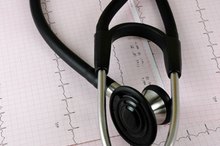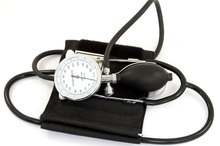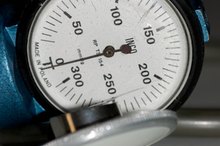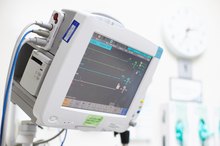What Are the Four Parts of the EKG Machine?
The EKG, or Electrocardiogram, is a machine used to monitor and evaluate possible heart problems in a medical patient 1. Small electrodes are placed on the chest, sides, or hips. The electrical activity of the heart will then be recorded on special graph paper for a final result. There are four primary elements on an EKG machine 1.
Electrodes
Electrodes consist of two types, the bipolar and unipolar. The bipolar electrodes can be placed on both the wrists and the legs to measure the voltage differential between the two. The electrodes are placed on the left leg and both wrists. Unipolar electrodes, on the other hand, measure the voltage difference or the electrical signal between a special reference electrode and actual body surface while being placed on both arms and legs. The reference electrode is a normal heart-rate electrode that doctors use to compare measurements. They can also be attached to the chest and watch for any changing heart patterns.
- Electrodes consist of two types, the bipolar and unipolar.
- The bipolar electrodes can be placed on both the wrists and the legs to measure the voltage differential between the two.
Amplifiers
How to Read an EKG for Dummies
Learn More
The amplifier reads the electrical signal in the body and prepares it for the output device. When the electrode's signal reaches the amplifier it is first sent to the buffer, the first section of the amplifier. When it reaches the buffer, the signal is stabilized and then translated. After this, the differential amplifier strengthens the signal by 100 to better read the measurements of the electrical signals.
- The amplifier reads the electrical signal in the body and prepares it for the output device.
- When the electrode's signal reaches the amplifier it is first sent to the buffer, the first section of the amplifier.
Connecting Wires
The connecting wires are a simple part of the EKG with an obvious role in the function of the machine 1. The connecting wires transmit the signal read from the electrodes and send it to the amplifier. These wires connect directly to the electrodes; the signal is sent through them and connected to the amplifier.
Output
How to Read an Abnormal EKG
Learn More
The output is a device on the EKG where the electrical activity of the body is processed and then recorded onto graph paper. Most EKG machines use what is called a paper-strip recorder. After the output records the device, the doctor receives a hard-copy of the measurements. Some EKG machines have record the measurements onto computers instead of a paper-strip recorder. Other types of recorders are oscilloscopes, and magnetic tape units. The measurements will first be recorded in an analog and then converted to a digital reading.
- The output is a device on the EKG where the electrical activity of the body is processed and then recorded onto graph paper.
- Most EKG machines use what is called a paper-strip recorder.
Related Articles
References
Writer Bio
A writer since 1995, Brooke Turner has been published in the "Duluth News Tribune" and "Ashland Daily Press," as well as various advertising publications. She is a freelance copywriter and the owner and operator of Blue Quill Writing Services in Ottertail, Minn. Turner also maintains two blogs: The Blog of Brooke and Blue Quill Writing.








